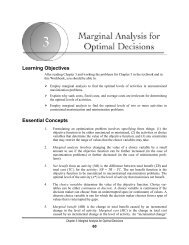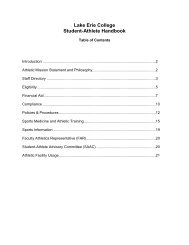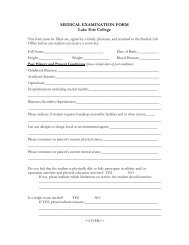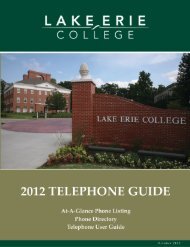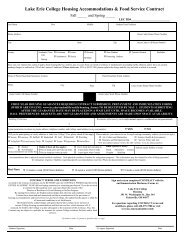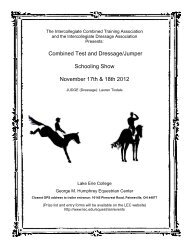Undergraduate Catalog - Lake Erie College
Undergraduate Catalog - Lake Erie College
Undergraduate Catalog - Lake Erie College
You also want an ePaper? Increase the reach of your titles
YUMPU automatically turns print PDFs into web optimized ePapers that Google loves.
Satisfactory Academic Progress Policy (SAP)<br />
Federal regulations require that schools monitor academic progress of each applicant for federal financial assistance and<br />
that the school certify the applicant is making satisfactory academic progress (SAP) toward earning his or her degree. To<br />
be eligible to receive financial aid from federal, state and institutional sources at <strong>Lake</strong> <strong>Erie</strong> <strong>College</strong>, students must make<br />
satisfactory academic progress in their degree or certificate programs. The measure of SAP is threefold: GPA, maximum<br />
timeframe and completion rate. Students who fail to meet the SAP requirements become ineligible to receive financial<br />
aid until compliance with these requirements are met.<br />
The Financial Aid Office evaluates SAP after the completion of each semester or term. All terms of enrollment, including<br />
summer, must be considered in the determination of SAP including periods in which the student did not receive federal<br />
student aid funds.<br />
Students academically dismissed from their academic program will be recognized as failing to meet SAP standards.<br />
The policy and terms described in this SAP policy is for financial aid purposes only and is separate from academic<br />
probation policies for academic standing with the college.<br />
SAP Terms<br />
Grade Point Average: (Qualitative Standard)<br />
An undergraduate student must maintain a minimum cumulative GPA of 2.0.<br />
Maximum Timeframe: (Quantitative Standard)<br />
An undergraduate student cannot exceed 150% of the published length of time of the program measured in credit hours<br />
attempted. Most undergraduate programs require 128 credit hours for graduation. The maximum time frame for these<br />
students is 192 hours (128 x 1.5). Students are normally expected to complete an undergraduate degree by the end<br />
of 4 years of full time enrollment. To make this progress, a student would need to take 16 credit hours each semester.<br />
The possibility exists for a student to receive financial aid up to the maximum time frame of 192 credit hours. However,<br />
if it is determined at any point that the student will not be able to complete the program within 192 credits, financial aid<br />
eligibility stops. The maximum time frame is not increased for dual-degree students or students with minors. Transfer<br />
credit hours accepted for the student’s academic program or degree are counted when measuring the maximum time<br />
frame to complete the degree or program and in hours attempted and earned.<br />
Completion Rate: Pace of Progression (Quantitative Standard)<br />
To ensure a student is making progress in progression toward their degree, a student must earn 67% of hours attempted.<br />
This is calculated by dividing cumulative hours earned by cumulative hours attempted.<br />
Attempted Credit Hours:<br />
Courses with grades and with marks of “W” withdrawn, “WF” withdrawal failure, “WP” withdrawal passing, “I” incomplete<br />
or “F” failure are counted as courses attempted. Course repetitions and remedial coursework count as credit hours<br />
attempted and count toward the maximum time frame.<br />
Earned Credit Hours:<br />
Credit hours recorded as earned on the student’s academic transcript at the end of each semester for which a student<br />
received a passing grade. An incomplete course or work in progress is not counted as earned credit hours.<br />
Credits excluded from the credit completion calculation include audit credits, CLEP, prior learning credits.<br />
Example: Joe Freshman was enrolled for 18 hours fall semester. He withdrew from a 4 credit hour course, receiving a “W”<br />
and failed another 4 credit hour course. At the end of the semester, his transcript showed he earned 10 credit hours. He has<br />
a 2.52 cumulative GPA. His percentage of credit hours earned based on his attempted is 55.5% (10/18). He did not make<br />
SAP for the fall semester based upon his earned hours. He must have had at least 67% earned hours from those attempted.<br />
SAP Warning, SAP Probation and Financial Aid Suspension<br />
SAP Warning<br />
The first time a student does not meet the SAP requirement the student will receive a SAP Warning. The student will<br />
be eligible to receive financial aid for the next semester. No other action is required by the student.<br />
SAP Probation and the Appeal Process<br />
68




